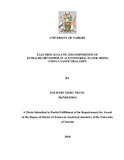| dc.description.abstract | This study investigated the electrocatalytic degradation of tetrachlorvinphos pesticide standard in acetonitrile-water media using cyanocobalamin catalyst. It was initiated by reports recorded from various consumers who link their ailment with possibility of pesticide residues in both flora and fauna. Although some studies have been done on electrochemical behavior and rate of degradation of pesticides, no detailed data is available on the same for tetrachlorvinphos pesticide. The study was carried out using cyclic voltammetry and UV-Vis spectrophotometry at a temperature of 24 ± 1 ˚C. The working electrode potential was concurrently recorded for the resulting current. A preliminary study for cyclic voltammetry was done using a well-known redox couple (Potassium ferricyanide) in order to calibrate the instrument and validate the results. The resulting voltammograms data were analyzed for fundamental information regarding the redox reactions. For UV-Vis spectrophotometry, absorbance values for substrate were recorded at the maximum absorption wavelengths for various concentrations. The data obtained were, analyzed and interpreted using Kaleidagraph software, version 4.1.1 and Microsoft Excel 2010 statistics software. The result shows that tetrachlorvinphos pesticide availed a two consecutive one-electron reduction peaks; the first (not well-defined) reduction peak at ~ - 0.710 ± 0.004 V and a second (well defined) reduction peak ~ -1.096 ± 0.029 V Versus Ag/AgCl. The diffusion coefficient was reported as 3.68 x 10-5cm2s-1. The current density was 5.83 x 10-5 A/cm2. The reduction potential for Tetrachlorvinphos pesticide in the presence of cyanocobalamin catalyst using a glassy carbon electrode was - 0.923 ± 0.03 V versus Ag/AgCl with a diffusion coefficient was 3.37 x 10-5 cm2s-1. The current density was 2.56 x 10-5 A/cm2. The value for reduction potential of Tetrachlorvinphos pesticide in the two cases resulted to lowering of over-potential by 0.168 V implying energy saving. The UV-Vis Spectrophotometer recorded maximum absorption wavelength of Tetrachlorvinphos alone at 250 nm and with a catalyst at (340.0, 400.0 and 540.0) nm respectively. This shows that, electrocatalytic reduction of tetrachlorvinphos pesticide occurred at a significantly lower potential compared to direct reduction with an energy saving of 0.168 V. Cyanocobalamin is a possible suitable catalyst for the degradation of tetrachlorvinphos. | en_US |



